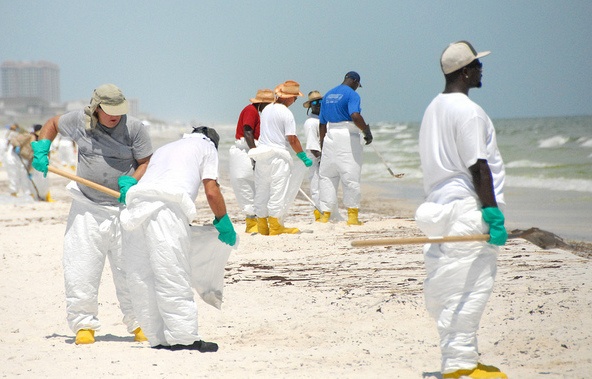INSTITUTE INDEX: The BP oil disaster's continuing toll on human health

Since the BP oil spill in the Gulf six years ago, studies have found that the chemical dispersant used to break up the slick can cause genetic changes in airway tissue linked to diseases like asthma. It also found that the wives of male cleanup workers were at greater risk for depression and domestic conflict. (U.S. Air Force photo by Tech. Sgt. Emily F. Alley via Flickr.)
Number of workers killed outright in the explosion that rocked BP's Deepwater Horizon drilling rig off the Louisiana coast six years ago this week, triggering the worst oil spill in U.S. history: 11
Number of workers injured in the explosion: 17
Estimated gallons of crude oil spilled: 134 million
Gallons of chemical dispersant used to break up the slick: 1.4 million
Number of people who filed medical claims under the financial settlement reached with BP, citing breathing problems, eye injuries and other illnesses related to exposure to the spill's pollution: more than 37,500
As of last year, number of studies published on physical health effects reported by people directly affected by BP's spill: 2
Number of those studies that found a higher frequency of respiratory illness, headaches, skin rash, and cough: 2
In one study looking at the disaster's effect on cleanup workers' lungs, number of genes in human airway cells found to be affected by exposure to a chemical oil dispersant used on the Gulf oil spill — with many of those same changes also observed in lung diseases like asthma and chronic obstructive pulmonary disease: 84
In another study looking at the mental health of wives of male cleanup workers, percent by which the odds of more partner fights increased for every unit increase in physical exposure to the spill: 38
Percent by which the women's odds of being unable to concentrate increased: 39
Percent by which their odds of depression increased: 47
Two years after the BP disaster, percentage points by which depression rates among residents of South Louisiana communities most exposed to the spill's pollution exceeded the national average: 25
Percentage points by which their rates of post-traumatic stress and anxiety exceeded the national average: 17
By which their rates of serious mental illness exceeded the national average: 14
Following the BP disaster, factor by which young people ages 18 to 25 living in spill-affected areas were more likely to suffer major depressive episodes: 1.8
To make suicide plans: 2.3
Years it can take for victims to recover from the psychological harm caused by oil spills: 10
(Click on figure to go to source.)
Tags
Sue Sturgis
Sue is the former editorial director of Facing South and the Institute for Southern Studies.
